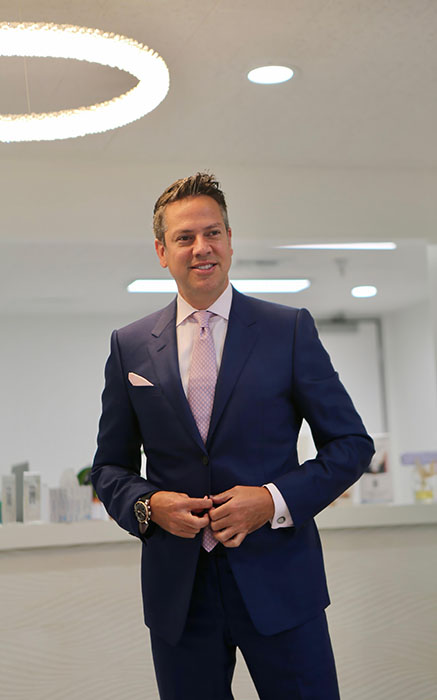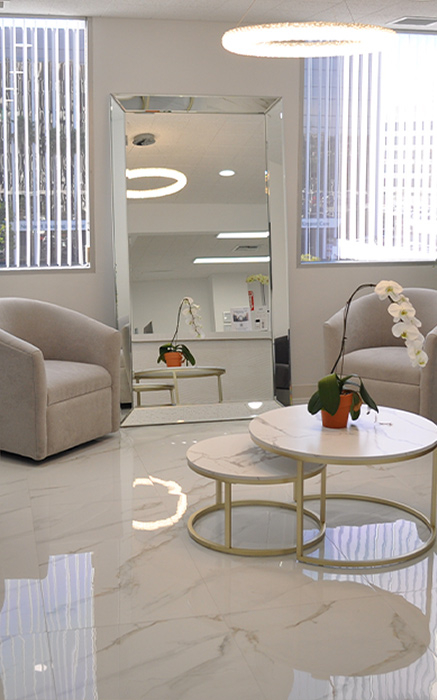Expertise in Breast Enhancement
Breast Implant Removal
What Is Breast Implant Removal?
Also called explant surgery, breast implant removal is a surgical procedure to remove silicone or saline implants. The procedure is typically performed in one of three ways: breast implant removal only, with capsulectomy, or en bloc capsulectomy.What Are The Benefits of Breast Implant Removal?
Reduced Physical Discomfort
Removing your breast implants can eliminate pain and discomfort from capsular contracture, breast implant illness, and too-large implants.Aesthetic Reasons
If you experience implant displacement, that means your breast implants have become incorrectly situated on your chest. Breast implant displacement or malposition can only be fixed with implant revision surgery.Easier Mammograms
Depending on the type of breast implant you have and where they are placed (above or below the chest muscle), implants can sometimes make it challenging to get a clear picture of your breast tissue during a mammogram. Removing the implants can make the process easier and allow the results to be read.Better Self-Image
Your idea of your ideal figure may change over time, as can your opinion about your own body or breast, and removing your implants may be a part of improving your confidence in your appearance.Am I a Good Candidate for Breast Implant Removal in Newport Beach?
- Are in good mental and physical health
- Want to improve the appearance of their breasts
- Are experiencing pain or discomfort
- Have experienced a leak or implant rupture
- Require implant replacement

Excellence & Artistry
Dr. Keyian Paydar is an award-winning clinical professor and board-certified plastic surgeon with over 20 years of experience. He performs a full spectrum of aesthetic plastic surgery procedures, including breast enhancement, tummy tucks, and liposuction, in addition to face procedures like facelifts, brow lifts, fat injection, and eyelid surgery.

Common Reasons to Have Breast Implant Removal Surgery
There are several reasons women choose to undergo breast implant removal, and they typically fall under two categories: medical and personal preference.
Capsular Contracture
Capsular contracture is the most common complication after breast augmentation surgery, affecting nearly one in six patients. While this may seem like a high number, the reality is that many women have a lesser degree of capsular contracture that doesn’t cause noticeable side effects. Capsular contracture occurs when the scar tissue capsule around the implant tightens, constricting the implant. The result is pain, hardness of the breasts, and changes to the shape of the breasts.
The cause of capsular contracture is unknown and it could be related to a low lying infection or inflammation around the implant but the only treatment option is removing the implant along with the firm capsule surrounding it.
Implant Failure
Breast implant failure is another way to describe your breast implant leaking or rupturing. If you have saline implants, you’ll notice a leak or rupture immediately, as your breast will deflate. Silicone implant ruptures are more difficult to discover because of the highly cohesive gel that fills the implant. If you experience a leak or rupture of your silicone implant, it may go unnoticed because the gel typically stays within the breast pocket. Any leak or rupture of either type of implant requires removal.
Breast Implant Illness (BII)
Breast implant illness is not an official medical diagnosis but rather a term to describe a group of symptoms that affect patients with breast implants. More research is needed to discover the cause of BII, but experts believe it may be due to an inflammatory or autoimmune response to breast implants. BII doesn’t necessarily appear immediately after breast augmentation; in fact, it may take years to develop. Symptoms of breast implant illness include:
- Joint and muscle pain
- Muscle weakness
- Chronic pain
- Headaches
- Fatigue
- Skin rashes or hair loss
- Breathing difficulties
- Brain fog, trouble concentrating, or memory problems
- Anxiety and depression
Like capsular contracture, the only way to alleviate BII symptoms is by removing your breast implants with or without the capsule surrounding them.
Breast Implant-Associated Anaplastic Large Cell Lymphoma (BIA-ALCL)
Breast Implant-Associated Anaplastic Large Cell Lymphoma (BIA-ALCL) is a rare type of non-Hodgkin’s lymphoma that develops around breast implants, predominately the textured ones. It originates in the fluid or scar tissue around the implant, not the breast tissue itself. Symptoms include persistent swelling, pain, or changes in breast shape. Diagnosis typically involves imaging and fluid or tissue sampling, with treatment usually requiring surgery to remove the implant and surrounding tissue. The cause is still under investigation, but textured implants have been predominantly linked to BIA-ALCL cases.
Implant Displacement
Breast implant displacement occurs when your implants move out of their intended position on your chest. There are three common types of implant displacement, including:
Bottoming out: when one or both implants slide below the breast crease due to being too heavy or because the supporting ligaments have stretched.
Lateral displacement: where the implants shift to the outside of your chest into the armpit, too far away from the midline, where cleavage is diminished as a result.
Symmastia: which occurs when the skin and muscle separating the implants in the middle of the chest detach, and the implants create a uniboob in the center of your chest.
Age of the Implants
While breast implants can last for up to 20 years, most are designed to be removed or replaced every ten years.
Changes to Your Lifestyle
Once you’ve gotten breast augmentation, there may come a time when changes to your life or personal aesthetic may move you to undergo implant removal. Some women may opt to get larger breasts, while others may choose smaller breasts or have the implants removed altogether. Maybe you desire a more natural look, or your larger breasts are getting in the way of physical activities you enjoy. Your favorite clothing may not fit well. Even weight fluctuations and the aging process may influence your decision to undergo explant surgery.
How Is Breast Implant Removal Performed?
Breast Implant Removal
En Bloc Capsulectomy
Total Capsulectomy
A total capsulectomy also uses your original incisions, if possible. An incision is made in the capsule, and the breast implant is removed. Once the implant is removed, the capsule is dissected and removed in one or multiple pieces. A total capsulectomy is used in cases of capsular contracture because the entire capsule must be removed before replacing the implant. Dr. Paydar may also choose this method over an en bloc procedure when a portion of the capsule has adhered to the rib cage or chest muscles. A partial capsulectomy is performed when the scar tissue needs to be left in place for safety or support. The chest muscle is then sutured down to its anatomical position.
Once the implants and capsules are completely removed, Dr. Paydar will assess the appearance of the breasts and make any aesthetic changes to ensure they look as healthy and natural as possible. If the breast tissue had a sagging appearance prior to the operation, then a breast lift will be performed if suggested during the preoperative consultation. The incision will be closed with sutures. Rarely will a drain be necessary, and the entire area will be protected with bandages. You’ll be taken to a recovery room, where you’ll be monitored until you’ve fully awoken from anesthesia.
What To Expect From Your Breast Implant Removal Recovery
You will experience soreness and discomfort for a few days after your breast implant removal, especially if the capsule was removed. Pain levels vary according to the type of implant removal, whether the implant was replaced, and whether muscle repair was performed. Drains are usually unnecessary, as Dr. Paydar uses quilting sutures to sew down the implant pocket.
Following your surgery, you will be wrapped in bandages and compression garments similar to those after your initial breast augmentation procedure. While all patients heal at their own pace, you should expect to take a week off work to recover. Any pain or discomfort can be remedied with over-the-counter anti-inflammatory or pain medications or those prescribed by Dr. Paydar. For a more comfortable and speedier recovery, try to get as much rest as possible for the first few weeks, as too much activity can cause inflammation, pain, and prolonged recovery time. You will need to avoid any type of chest exercises as well until you are cleared by Dr. Paydar.
The duration of your recovery will depend on the extent of your surgery. If you had an en bloc or total capsulectomy and new implants were placed, your recovery time and expectations will be similar to your original augmentation surgery. If there are implant malposition issues, Dr. Paydar may have to perform a capsulorrhaphy or create an internal bra using mesh or human tissue. During your consultation, Dr. Paydar will discuss what you should expect regarding your recovery.
Dr. Paydar has now added Elixir MD™ to his patients’ surgical protocol to lessen the risk of infection and speed recovery. Elixir MD™ uses light at varying wavelengths to penetrate the skin at specific depths and activate distinct healing mechanisms. Prior to surgery, Dr. Paydar uses the Elixir MD™ Detox™ Treatment to reduce bacteria in the patient’s body, reducing the risk of infection. After surgery, he uses one of the other Elixir MD™ light treatments to help minimize bruising and swelling and accelerate healing for a more rapid recovery.
How Much Does Breast Implant Removal Cost in Newport Beach, CA?
The estimated average cost of breast implant removal can vary widely, depending on the complexity of the surgery itself and additional charges such as anesthesiologist fees and prescription medications. The cost of your breast implant removal will also be affected by whether you decide to replace your implant, undergo a breast lift, or require more in-depth repair of the breast area due to implant malpositioning. During your consultation at Paydar Plastic Surgery, you will sit down with a member of our financial team to receive a detailed cost estimate.Why Choose Dr. Paydar for Breast Implant Removal?
Dr. Keyian Paydar is an award-winning clinical professor at UC Irvine and a board-certified plastic surgeon with over 20 years of experience in complicated and complex breast reconstruction, revision, and cosmetic breast procedures. His expertise and skill in breast surgery are second to none, so you’re sure to be thrilled with the results of your breast implant removal. Dr. Paydar is a leading plastic surgeon in the Newport Beach community who understands the emotional and physical toll of breast implants that need revision. During your one-on-one consultation, Dr. Paydar will evaluate your medical history, your implant complications or reasons for your dissatisfaction, and your goals so that he can establish the best course of action to allow you to reach your desired results.Schedule Your Breast Implant Removal Consultation in Newport Beach
To learn more about Newport Beach breast implant removal surgery with Dr. Paydar, schedule your personalized consultation at Paydar Plastic Surgery by contacting our office by phone at (949)755-0575 or completing the online contact form. We will work closely with you to schedule a time that allows you to ask questions and fully understand the procedure from start to finish.


